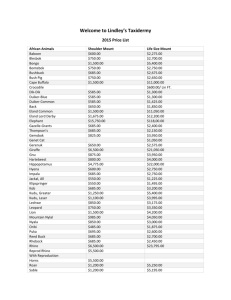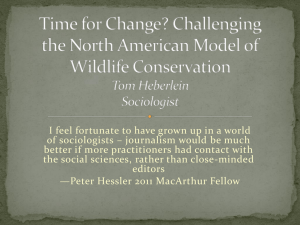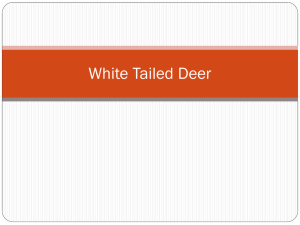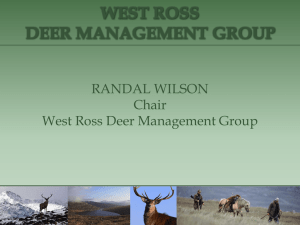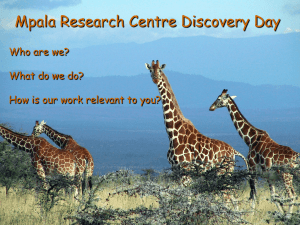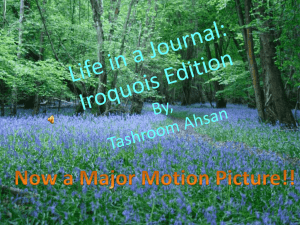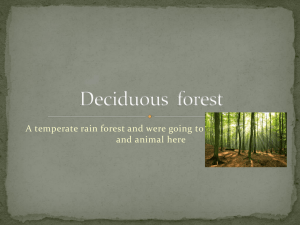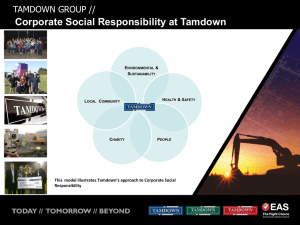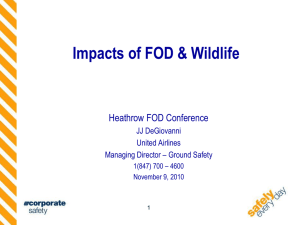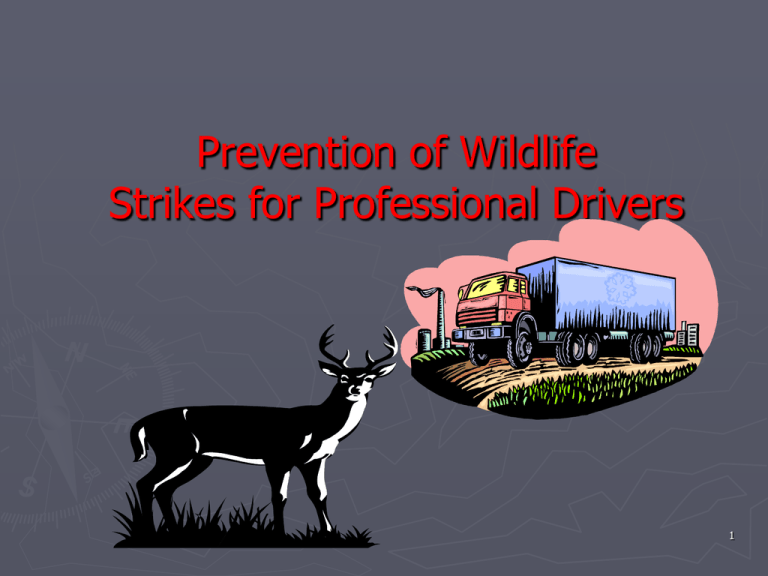
Prevention of Wildlife
Strikes for Professional Drivers
1
Safety culture and the Normative behaviour we can develop:
Prevention
► We
conducted a Survey on vehicle wildlife
collisions found that there were driving
habits and driver characteristics that were
more conducive to preventing collisions.
The study also found some common quotes
from drivers who had hit deer.
3
Quotes from Drivers who have
hit wildlife:
► “I
didn’t see the second one”
► “I didn’t think it was going to run onto the
road”
► “I assumed it would run off the road”
► “I took my eyes off the road for just a
second to ...(adjust radio, sip coffee, etc,
etc) and it just appeared”
► “I was doing the speed limit”
4
Safety Check
► Doppler
Effect of Sound; the sound of tires
on pavement or engine is behind you which
confuses the animals.
► Light at Dusk : especially Deer have highly
sensitive Vision, Headlights probably look
like the sun and they just stand there.
5
How to Avoid Wildlife Incidents
Understand the Wildlife Season
Know the type of Wildlife
Know your area
Train your eyes
Reconsider your Road Radar
6
6
Know the Season
•“The Rut” typically lasts 2 weeks but
can occur anytime during the month
depending on weather, moon phase
and day length.
•The main key is weather, if your
travel day falls during the rut a day
with rapid barometric drop (i.e.: gets
very cold very fast – “a front is
moving in”) will be a high movement
day.
•Males will move all day non-stop on
the peak rut days
7
Maximum Movement
• Male ungulates (Deer, Moose, Elk) will maximize
their movements during the rut
►Elk
– Mid Sept – Mid Oct
►Moose – End Sept – End Oct
►Deer – November
► Consider
the time of year and what travel
patterns animals will likely make before you
travel.
8
RUT:
X= Strikes, Y=Time of Year
30
25
20
15
10
5
0
Jan
Statistics - Canada
Mar
May
Jul
Sep
►Elk – Mid Sept – Mid Oct
►Moose
Oct
Nov
Deer – November
– End Sept – End
9
Incidents :Type of Wildlife
Moose
7%
Birds
6%
Bear
4%
Elk
2%
Deer
81%
Statistics - Canada
10
DEER = 81%
11
Deer
• 2 species (Mule deer and Whitetail) act
differently
►Mule
deer are more social, tend to travel in
groups
►Whitetail are more solitary. In spring of year
does travel with fawns. Fawns will lag behind
the doe
12
Safety Check
► If
you see an animal on one side of the
road, check the other side, especially if the
animal is looking over its back across the
road, it is likely waiting for more animals.
► Young deer will stay focused on their
mother, not on the danger of their
surroundings; if she ran safely across they
will do the same despite your proximity
change.
13
DANGER:VEGETATION
► When
trees or Brush come close to the road
the Driver cannot respond quickly enough to
avoid a collision.
► Where vegetation has been cleared 40
meters to the side of the road we seldom
see Deer Collisions.
(cite: Found R., Boyce M.,)
14
MOOSE = 7%
KING OF THE FOREST
WILL MOVE
IF IT WANTS TO.
15
Safety Check:
Know the type of Wildlife
Moose
• During the rut males will be alone and on
the move or may have a harem of cows with
them. In the winter they will herd up
regardless of sex.
• Spring bulls will form bachelor herds and
will feed for the rut. (May is a high
movement time as they spread out for fresh
feed)
• If they are with cows they will stay close
and are protective of them. If encountered
like this they may not back down from your
vehicle choosing to challenge instead.
16
Birds = 6%
17
Bird Strikes
► Happen
at Dusk or Dark: Predators
► During Early Morning and Dusk: Migration
► The bigger Birds usually end up in the Seat
next to you or on your lap.
► Some are feeding on the Deer that was hit
earlier in the morning.
18
Bear = 4%
19
Bear Tracks
► Non
–Existent in Winter
► Spring: Dependant on the weather
► Summer: Heavy Movement Early Morning or
Dusk.
► Fall: Feeding for Winter heavy Movement
20
ELK = 2%
21
Elk Characteristics
► RUT:
Elk – Mid Sept – Mid Oct
► Tend to stay near Water.
► In the National Parks they are almost
domestic but are unpredictable during the
RUT.
22
Domestic
23
PREVENTION
► There
is signage for all types of Wildlife.
► The Signs are well coded.
24
Light Conditions at time of the
Incidents
Daylight
8%
Fog
4%
Night
15%
Dusk
8%
Statistics - Canada
Dawn
65%
25
Time of Day
• Game movements will differ by season and time
of day.
►The
hour around dawn and dusk are the
heaviest movement times (half hour before
and after sunrise or Sunset).
► What
time is sunrise or sunset, do I have to
travel one hour before or one hour after
these times?
26
Safety Check: Driver Fatigue
► There
seems to be a correlation between
the Animal Strikes and Fatigue.
► The frequency of Animal Strikes and time or
light conditions.
27
Time of Day- Fatigue and
Crashes…
28
What Do We Mean By Fatigue?
►
►
►
►
►
►
►
Reduced Attention
Increased Reaction Time
Impaired Physical/Mental/Performance
Reduced Ability To Integrate Information
Irritability, Short Fuse
Reduced Ability To Respond Appropriately To
Complex, Stressful Situations
Spontaneous Sleep
29
Why Worry About Fatigue?
►
►
►
Fatigue can lead to errors
Fatigue increases the risk of serious accidents
Driver Safety can be improved by managing fatigue
30
Strike Location
Urban
4%
Lease
31%
Hwy
65%
Statistics - Canada
31
Spot Wildlife sooner
Often it is almost impossible to spot
a well hidden animal, their eyes are
perfectly symmetrical and reflective
of light in day and night.
You can train your eyes to become
attuned to small dark round objects
as well. You can often spot an
animal by it’s eye alone.
32
KNOW YOUR AREA
You can reduce your chances of a
wildlife encounter by knowing the type
of wildlife in your area of travel and
how to react to the conditions, slow
down.
Eg. During Planting or Harvesting there
will be more wildlife on the move from
the Farm Machinery
33
Know the type of Wildlife
Here are mule deer, how many do you
see?
34
34
Know the type of Wildlife
35
35
Train your eyes
36
36
Reconsider your Road Radar
► What
is the moon phase and how will it
effect their movement?
► What season am I in and how will it
affect the animals?
► Is it hunting season and are hunters
pushing animals around increasing the
chance of encounters on roads or
highways?
37
37
Radar
► Will
I be driving through wooded areas or
old farmsteads on my travel route? Identify
key movement areas as you drive.
► Animals on the road are unpredictable, keep
your vehicle straight, and make noise to get
the animal moving out of the path of your
vehicle. Slow down or stop if safe to do so.
38
Radar (cont.)
► How
did that animal react to the car in front
of me? Be prepared and do not assume the
reaction will be the same for you.
The above points are not proof against a
collision with an animal, but in Assessing
and analyzing the risk allows you to ensure
you are acting safely.
39
Characteristics of Driver’s who
don’t hit wildlife:
►Use
high beams whenever possible
►Scan the ditches for movement and
eyes
►Slow down in areas of known deer
activity
►Recognize high population areas
40
Characteristics of Driver’s who
don’t hit wildlife:
► Recognize
road/bush characteristics that will
attract deer
► Slow down even when the deer is not on
the road
► Always anticipate more than one deer and
expect erratic movements
► Recognize the glow of the eyes in the
headlights
► Plan their drive to avoid ‘deer rush hour’
41
Personal Protective Equipment
► Moose
Bumpers
► Yellow
Tinted Glasses for Adverse
Conditions
► Night Vision Cameras
42
How to Avoid Wildlife Incidents
Understand the Wildlife Season
Know the type of wildlife
Know your area
Train your eyes
Reconsider your Road Radar
43
43
Evasive Maneuvers
► Brake
effectively.
► AIR-HORN
► Company Policy Dictates
► Dangerous Goods ( eg. Liquid):
Hold the Line and Stay in your lane.
► PDIC: Go Right to edge of shoulder.
► Do not go off the road or try to pass the
deer.
44
Proper Documentation &
Secure area
► Pictures
► Accident
Report
► Danger to public if Carcass is left on road
► Emergency Procedures (Company)
► Proper Placement of Triangles marking
Incident.
► Evidence (Be Careful): the animal does not
have to be chained to the truck.
45
Contributors
► Don
Chapman ; Canadian Freightways
► Ray Hamel; Imperial Oil
► Kim Hrushenski; Partners in Compliance
► Rob Found; Department of Biological Sciences;
University of Alberta
► Mark S. Boyce; Department of Biological Sciences;
University of Alberta
► The hundreds of Professional Driver’s: I work with
everyday.
46
Questions?
47


